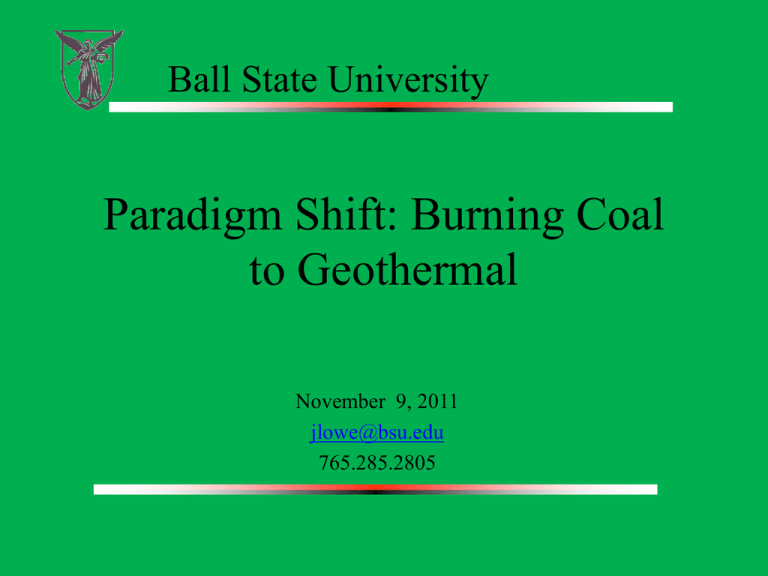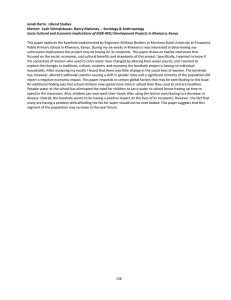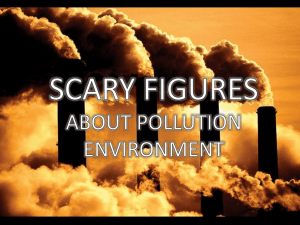Paradigm Shift: Burning Coal to Geothermal
advertisement

Ball State University Paradigm Shift: Burning Coal to Geothermal November 9, 2011 jlowe@bsu.edu 765.285.2805 Founded in 1918 6.7 M square feet 660 acres 22,000 students Heat Plant and Chilled Water Plant Operations Heat Plant: 4 Coal Fired Boilers 3 Natural Gas Fired Boilers 320,000 Lbs/Hr nameplate capacity 240,000 Lbs/Hr current capacity 700,000,000 Lbs/Year Chilled Water Plant: 5 Electrical Centrifugal Chillers 9,300 ton capacity 25,000,000 Ton Hours/Year (4) stoker coal fired boilers (2) installed 1941 (2) installed 1955 (3) Natural Gas Fired Boilers (2) installed in late 1960s (1) installed in 1970 Typical Air Handling Unit Chilled Water Coil- 42 degree F water Hot Water Coil- 150 degree F water Ball State Annual Utility Use • Coal 36,000 tons • Electricity 110,000,000 kwh • Natural Gas 150,000,000 cf Pollutants Produced from Burning Coal • • • • • Carbon Dioxide 85,000 tons Sulfur Dioxide 1,400 tons Nitrogen Oxide 240 tons Particulate Matter 200 tons Carbon Monoxide 80 tons (Global Warming) (Acid Rain) (Smog) (Breathing) (Headache) Circulating Fluidized Bed Boiler • Ten story structure • Burn 70% fossil fuel with 30% alternative fuels • Approximately 15% more efficient • Estimated Cost $65 $70 million • Equipment made in China Law of Thermodynamics • energy (heat) moves from a warmer area to the cooler area • Summer: water entering the loop field is “warmer” than the ground--- heat moves from (warm) water to the (cool) ground • Winter: water entering the loop field is “cooler” than the ground---heat moves from (warm) ground and to the (cool) water Laws of Thermodynamics “Engineers Holy Grail” Zeroth law: “Thermal equilibrium” if two thermodynamic systems are each in thermal equilibrium with a third system, then they are in thermal equilibrium with each other. First law: “Conservation of energy” energy can neither be created nor destroyed. It can only change forms. Second law: “Energy flows from higher to lower temperature objects” heat can spontaneously flow from a higher temperature region to a lower temperature region, but not the other way Third law: “Minimum Kinetic Energy” As temperature approaches absolute zero, the molecular kinetic energy of a system approaches a minimum, 0 degrees K, -273.15 degree C or -459.67 degree F. Campus Heating and Cooling Loads •Building Heating Loads (Mbtuh) •Hot Water Flow (GPM ) •Building Cooling Loads (Tons) •Chilled Water Flow (GPM) Conductivity Test • Actual completed borehole with loops installed • Water circulated through loop as heat is input and temperature of water measured over time • Designed for 1.51 Btu/hr-ft-F • Actual tested average of 2% of the 1,800 installed boreholes was 1.91 Btu/hr-ft-F • Equates to a capacity of about 2.5 tons per borehole Borehole Design Software Inputs •Conduct-Ground/Grout •Cooling Loads-Total/Peak •Heating Loads-Total/Peak •Flow Rates •Double/Single loop •Borehole Spacing •Water Temp- Heat/Cool Output •Total Feet Borehole Borehole Field Design •Spaced 15 feet apart •225 square feet per borehole •400/500 feet deep •Double and Single Loop •1-1/4 inch outside diameter pipe •High Density Polyethylene 2D Resistivity Testing: Paths Across Site 2D Cross Section Senator Richard Lugar Geothermal Groundbreaking Ceremony, May 9, 2009 Drilling Rigs Averaged one borehole per rig per day Vertical Closed Loop Borehole (2) loops: 1-1/4 diameter HDPE Grout Tremie Line: fill pipe for bentonite and sand mixture Borehole Field North: 15 feet spacing 400 feet deep Double Loop South: 15 feet spacing 500 feet deep Single Loop Loop Field Headers 16,000 to 20,000 GPM CYK York Chillers: (4) 2,500 ton R134A Refrigerant 150 degree F hot water 42 degree F chilled water 10 miles of hot water supply and return pipe Geothermal Conversion Cost Components • • • • • • Boreholes Distribution Pipe Building HVAC Modifications District Energy Buildings Heat Pump Chillers High Voltage Improvements Estimated Construction Cost $78-83 million Pollutants Eliminated with Geothermal Conversion • • • • • Carbon Dioxide 75,000 tons Sulfur Dioxide 1,400 tons Nitrogen Oxide 240 tons Particulate Matter 200 tons Carbon Monoxide 80 tons Energy and Dollars Saved BTUs per year reduction 500,000,000,000 40% less BTUs/SF/Year Dollars Saved $2,000,000 Ball State University’s Geothermal Project Visits and Inquiries Colleges & Universities • • • • • • • • • • • • Dartmouth College Stanford University University of Notre Dame Ohio State University University of Iowa Northern Kentucky University Colorado College Slippery Rock University Hampton University Pratt Institute Oakland University Purdue University Potential: 6,000 District Energy Systems in North America; 10% of non-residential floor space in the U.S. • • • • • • • • • • • • University of Michigan The Evergreen State College Northwestern University University of Illinois Ohio University Lake Land College Indiana University-Purdue University Indianapolis DePauw University University of Washington Montana State University-Bozeman Penn State University Miami, Ohio University Ball State University’s Geothermal Project Visits and Inquiries • • • • • • • • • • • U.S. Department of Energy Indiana Department of Natural Resources Indiana Office of Energy Development Representatives of Isparta, Turkey National Wildlife Federation Union of Concerned Scientists Building Indiana Magazine WFYI Indiana Expeditions The Chronicle for Higher Education Delta Sky Magazine Second Nature (2010 Climate Leadership Award) • • • • • • • • • • • • Geo Outlook Magazine Allison Transmission Waterwell Journal International District Energy Association Biz World The Christian Science Monitor National Public Radio Argonne National Laboratory National Ground Water Association Hoosier Environmental Council (2010 Technology Innovator of the Year Award) Waste Management General Service Administration Ball State University Paradigm Shift: Burning Coal to Geothermal November 9, 2011 jlowe@bsu.edu 765.285.2805


